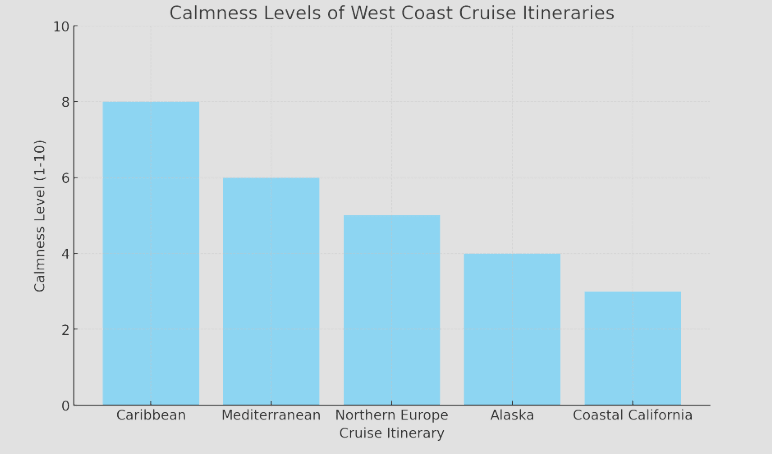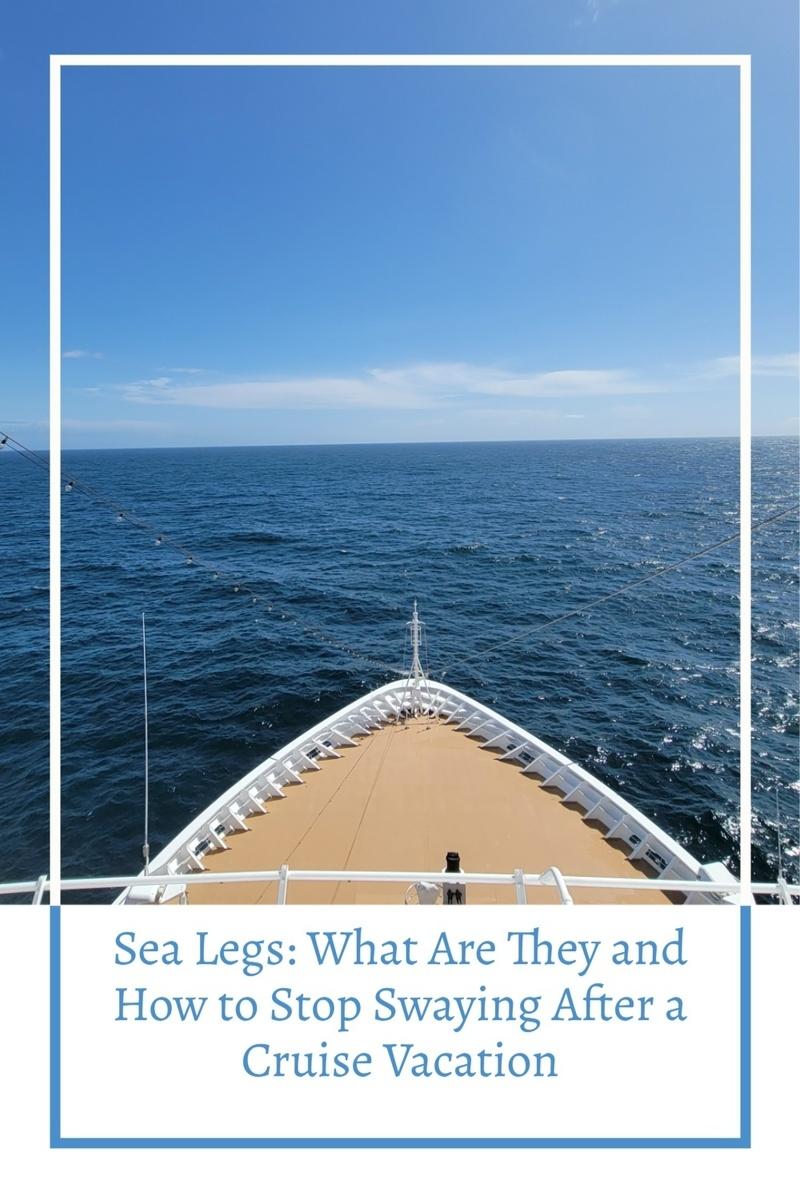If you just got back from your cruise vacation and are feeling unsteady, you may be wondering what's going on. Aren't so-called "sea legs" a good thing that helps the human body adapt to motion caused by unstable water? Well, after spending several days - or even weeks - traveling on the ocean, your body has adapted and now it needs to adapt to life back on land again. This is the quick answer to why people feel like they are still swaying … even after the cruise is over.
Questions
How Many West Coast Cruises Have You Taken?
What To Know About Sea Legs Before Booking Your Next Cruise
- Choose the right cabin location - Lower deck, midship accommodations minimize ship movement
- Pack motion sickness remedies - Natural options like ginger and medical alternatives from your doctor
- Plan for readjustment time - Most people need 1-2 days to regain their land legs after disembarking
- Consider cruise routes carefully - Inside Passage Alaskan cruises offer calmer waters than repositioning cruises passing along the Oregon Coast
- Contact Heather from Flow Voyages - She can help select optimal cabin locations and provide guidance on accessibility needs using our form to Book A Cruise
Article Index
- Understanding Motion Sickness and Sea Legs
- Best and Worst West Coast Cruises For People Worried About Motion Sickness
- How Calm Are Alaska Cruises vs. the Caribbean?
- Cruise Motion Sickness vs. Post-Cruise Swaying
- Service Dogs and Sea Legs
- Why Do I Feel Like I'm Still Swaying After My Cruise? Understanding Land Sickness
- How Long Does It Take To Readjust To Life On Land?
- What Are Some Tips For Stopping The Swaying Sensation?
- Land Sickness: What to Expect
- Getting Your Land Legs
- Mal De Débarquement Syndrome - When The Swaying Doesn't Go Away
- Most Healthy Individuals Don't Get Seasick
- Planning Your Perfect Cruise Experience
Understanding Motion Sickness and Sea Legs
Motion sickness is a common issue that many people face when traveling by boat, car, or plane. It happens when your body receives conflicting signals from your senses, such as your eyes, ears, and sensory nerves. This sensory conflict can lead to a range of uncomfortable symptoms, including dizziness, nausea, vomiting, and headaches. Essentially, your brain gets confused by the mixed messages, and this confusion manifests as motion sickness.
What Are Sea Legs?
Sea legs refer to the ability to move confidently on a ship or vessel without experiencing motion sickness. This adaptation occurs when your inner ear and brain resolve the conflicting messages caused by the constant movement of the ship. The inner ear plays a crucial role in maintaining balance and equilibrium, and the brain processes information from the inner ear to help you stay oriented. When you have your sea legs, it means your body and brain have successfully adapted to the ship's constant motion, allowing you to move around without feeling dizzy or nauseous.
The phrase "finding your sea legs" describes adapting to a ship's motion until you can maintain balance despite the rocking. Dating back to the 1700s, this phrase originally referred to new sailors acclimating to work on naval vessels during long voyages across rough seas, later expanding to describe mastering any challenging task. While most people focus on adjusting to shipboard movement, fewer consider the reverse phenomenon - readjusting to solid ground.
Best and Worst West Coast Cruises For People Worried About Motion Sickness
This is one of the most frequently asked questions we receive from clients who ask us to help plan their cruise ship vacation. Unfortunately, there are too many variables ever to promise a completely calm cruise, but certainly, some cruises will be better than others. While no itinerary will be 100% calm, and some people are more sensitive to the rocking of the ship caused by the ocean, some itineraries will be better than others if motion sickness on a cruise is a concern.
Best Cruises For People With Motion Sickness:
Inside Passage Alaska cruises sailing out of Vancouver will feature protected waters for most of your voyage without significant amounts of exposure to ocean swells. Great Lakes cruises also offer relatively calm waters, although these large lakes can experience rolling or choppy conditions during sudden weather changes, and this is compounded by the fact that these vessels are much smaller than the huge cruise ships out on the open ocean. Similarlly, Canada New England cruises exploring Nova Scotia's protected harbors and coastal waters typically offer smoother sailing than open ocean routes.
Worst West Coast Cruises For Motion Sickness:
Repositioning cruises to Seattle or Vancouver that pass by the Oregon Coast have a bad reputation for experiencing rough waters regularly. Specifically, the area between San Francisco and Astoria, Oregon but also all the way up the coast until you sail through the Straight of Juan de Fuca and ultimately enter the calm waters of the Salish Sea.

How Calm Are Alaska Cruises vs. the Caribbean?
Caribbean waters are among the consistently calm cruise areas found anywhere in the world. However, cruises to Alaska, Coastal California, and the Mexican Riviera can have some pretty significant ocean swells - though typically far from anything that would be generally uncomfortable for most guests. However, if you have taken a Caribbean cruise before and felt issues with sea legs, swaying after disembarkation or a general feeling of discomfort due to the motion, then you should prepare accordingly and pack sea sickness remedies to help.
The vestibular system, which helps maintain balance, can be affected differently depending on the calmness of the waters. With that being said, as someone who has been on nearly two dozen cruises across both the Caribbean and Pacific Coastal itineraries, this comparison is somewhat deceptive. The simple reason for this is that while most Caribbean itineraries take place close to islands that are protected from ocean swells - Pacific cruises - in particular those to Alaska - have EXTREMELY CALM waters once you get into the inside passage, even though the waters west of Vancouver Island can sometimes be rough.
Alaska cruises departing from Seattle must cross two full days of open Pacific Ocean waters before entering the protected Inside Passage, which can be rough. Similarly, I find that the seas are far calmer in the triangle area between Cabo, Puerto Vallarta, and Mazatlan than the seas off the coast of Baja.

Cruise Motion Sickness vs. Post-Cruise Swaying
Motion sickness on cruises and post-cruise swaying sensations are related but distinct phenomena. It is essential to distinguish these from other vestibular disorders that may produce similar symptoms. Both involve your vestibulo-ocular reflex, where your brain receives conflicting messages from your eyes and inner ear.
What Causes Seasickness on a Cruise?
Seasickness typically stems from unfamiliar ship movements, engine vibrations, and the disorienting effect of watching the horizon move relative to the ship. Smaller vessels experience more pronounced motion in rough seas, though individual susceptibility varies significantly based on personal sensitivity and prior experience with maritime travel.
How to Prevent Seasickness on Your Cruise
Choosing lower deck, midship accommodations minimizes exposure to the ship's most pronounced movements, while avoiding top decks and extremities (forward lounges, aft dining areas) reduces disorientation. Natural remedies, such as green apples and ginger, can help manage mild symptoms, while newer ships with advanced stabilizers offer smoother sailing experiences overall.

Service Dogs and Sea Legs
Service dogs traveling on Alaska cruises and other West Coast itineraries can experience motion sensitivity similar to their human companions. Major cruise lines, including Royal Caribbean and Carnival, welcome properly trained service animals that meet ADA requirements - specifically, dogs individually trained to perform tasks for people with disabilities. It's important to note that under ADA regulations, only service dogs are permitted; emotional support animals are not accommodated under these rules.
According to veterinary research, dogs experience motion sickness through the same inner ear mechanism as humans - when their vestibular system becomes disrupted by ship movement. This can manifest as excessive drooling, restlessness, or nausea. Younger dogs are more susceptible to motion sickness, with many outgrowing the condition by age one, paralleling how humans adapt to maritime environments.
P&O Cruises and Cunard specifically recommend consulting veterinarians about motion sickness before cruising with assistance dogs. Preventive measures include limiting food intake before embarkation, ensuring access to fresh air and water, and discussing anti-nausea medications with your veterinarian. Service dog training programs often include desensitization to various transportation modes, though cruise ship motion presents unique challenges.
For travelers seeking to bring pets (rather than service animals) across the Atlantic, Cunard's Queen Mary 2 offers a unique kennel program with 24 air-conditioned accommodations and dedicated staff care during Transatlantic crossings to New York. This service is separate from their service animal accommodations and requires advance booking.
Cruise lines provide designated relief areas with proper drainage and materials, typically located on open decks where fresh air helps minimize motion sensitivity. Service dog owners should plan for the adjustment period their animals may need, just as humans require time to find their sea legs and later readjust to land.
Why Do I Feel Like I'm Still Swaying After My Cruise? Understanding Land Sickness
If you are feeling like you're still swaying after your cruise, it's because your body has adapted to the motion of being on a boat. Just like it took time for your body to adjust to being on the water, it will take some time for your body to adjust back to life on land. This is perfectly normal and there is no need to be concerned. The best thing you can do is give yourself some time to readjust.
In addition to the swaying sensation, other symptoms of MdDS can include unsteadiness, increased sensitivity to visual stimuli, and potential mental health concerns such as anxiety or depression. Like the feelings of seasickness, this is more commonly experienced among women due to a number of factors including the fact that Estrogen can contribute to feelings of motion sickness and this is often made worse by birth control pills that contain it as well as Estrogen supplements that are designed to help compensate for hormonal changes in middle-aged women.
How Long Does It Take To Readjust To Life On Land?
It usually takes a day or two for your body to readjust after being on a boat. For some people, readjusting to walking around on dry land can take just a few minutes. However, if you are still feeling unsteady after a few days, it's best to consult with your doctor.
What Are Some Tips For Stopping The Swaying Sensation?
If you are looking for ways to stop the swaying sensation, there are a few things you can try. However, for most people, the swaying sensation will go away quickly in just a few days of being off the water. Luckily there are plenty of effective remedies that will work for most people. This can be confusing the first time it happens and first-time cruisers returning after long trips may experience a brief period of these symptoms but that doesn't make it any less surprising. These methods can help alleviate symptoms and make the transition back to land more comfortable.
- Get plenty of rest: Your body handles stress and adapts to change better when well-rested. Prioritize good sleep and take breaks during the day when possible.
- Drink lots of fluids: Dehydration can worsen sea legs symptoms. Stay hydrated with water and avoid alcohol during readjustment.
- Eat light meals: Smaller, lighter meals help minimize nausea and dizziness.
- Avoid alcohol: Alcohol dehydrates your body and can intensify sea legs symptoms during readjustment.
- Stay cool: If experiencing nausea, maintain a cool body temperature with fluids and cool showers or baths.
- Get fresh air: Time outdoors can reduce sea legs symptoms. Take walks, swim, or simply sit outside.
- Do some light exercises: Movement helps your body adjust faster. Try walking, swimming, or yoga (consult your doctor before starting any new routine).
- Avoid sudden movements: Quick direction changes or stop-and-start activities can worsen symptoms.
While each person's physiology is unique, a combination of these methods to alleviate the swaying sensation will work for most people.

Land Sickness: What to Expect
When you return to land after a long voyage, you might experience a phenomenon known as land sickness or mal de debarquement syndrome. This condition is characterized by feelings of unsteadiness, dizziness, and nausea, similar to motion sickness. Land sickness occurs because your body needs time to adjust from the constant motion of the ship to the stillness of land. Just as it took time for your body to adapt to the ship's movement, it will take some time to readjust to being on solid ground.
Getting Your Land Legs
Getting your land legs back after a long voyage can take some time, but there are several things you can do to help your body adjust:
- Take it easy: Give your body time to adapt to the change in environment. Avoid strenuous activities and take regular breaks to rest.
- Stay hydrated: Drink plenty of water and other fluids to help your body recover from the voyage.
- Get fresh air: Spend time outdoors and get some fresh air to help your body adjust to the change in environment.
- Avoid heavy meals: Eat light meals and avoid heavy or greasy foods that can exacerbate nausea and dizziness.
- Practice relaxation techniques: Try relaxation techniques such as deep breathing, meditation, or yoga to help manage stress and anxiety.
By following these tips, you can help your body regain its balance and feel more comfortable as you transition back to life on land.
Mal De Débarquement Syndrome - When The Swaying Doesn't Go Away
Literally meaning "disembarkation sickness", Mal de Débarquement Syndrome (MdDS) is a motion disorder that can occur after exposure to motion, such as being on a boat or ship. MdDS is less common than sea legs, but it can be more severe and long-lasting.
To diagnose MdDS, doctors typically exclude other vestibular disorders, as there are no specific clinical markers for the condition. Treatment options, such as vestibular rehabilitation therapy, aim to retrain the brain's processing of motion, with a focus on the vestibular system.
Symptoms of MdDS include:
- a feeling of continuous rocking or swaying, even when you're not in motion
- fatigue
- trouble sleeping
- anxiety
- depression
- difficulty concentrating
If you're still feeling unsteady several days after your cruise, consult your doctor. While brief post-cruise rocking sensations are normal, persistent symptoms may indicate Mal de Debarquement Syndrome (MdDS).
MdDS symptoms include continuous rocking/swaying sensations while stationary, fatigue, sleep issues, anxiety, difficulty concentrating, and possible depression. Many sufferers notice symptoms worsen throughout the day and are less noticeable upon waking, suggesting connections to fatigue or stress.
Treatment options include medication, vestibular rehabilitation therapy to retrain your brain's motion processing, and lifestyle adjustments like avoiding alcohol, getting adequate rest, and eating lighter meals.
Most Healthy Individuals Don't Get Seasick
According to the CDC, approximately one in three people experience motion sickness at some point in their lifetime, with women and children ages 2-12 being most at risk. However, on modern cruise ships with advanced stabilization systems, seasickness affects far fewer passengers, and even fewer feel dizzy after returning to land. Post-cruise swaying sensations typically last only a short time.
Most cruise ships sail in calm waters like the Caribbean, though rougher seas can occur in the Mediterranean, Northern Europe, Alaska, and coastal California. Pregnancy, menstruation, and hormone replacement therapy can increase susceptibility to motion sickness symptoms.
To minimize motion sickness risk, choose optimal cabin locations, avoid older and smaller ships, consider sailing calmer routes, limit alcohol and heavy meals on your first night, and initially avoid higher decks and the ship's front.
A travel advisor can help first-time cruisers select appropriate accommodations and provide practical tips for a comfortable experience. For personalized assistance with booking considerations and accessibility needs, consider reaching out to Heather Hills from Flow Voyages, who can help answer questions and assist you in finding the perfect cruise for your needs using our form to book a cruise.
Planning Your Perfect Cruise Experience
Understanding motion sickness and post-cruise adjustment helps ensure your West Coast cruise adventure remains memorable for all the right reasons. Whether you're planning Alaska cruises through protected Inside Passage waters or considering Mexican Riviera itineraries, proper preparation makes the difference between discomfort and discovery.
From choosing the right cabin location to understanding what happens when you return to land, knowledge empowers you to make informed decisions about your cruise vacation. Remember that getting your sea legs - and later your land legs - is a natural adaptation process that varies among individuals, but rarely prevents people from enjoying the incredible experiences that West Coast cruising offers.
Thanks for reading. We hope this was helpful!
Why stop now?
Participate In Our Polls | Ask or Answer A Cruise Question | Contact Heather to Book Your Next Cruise!

